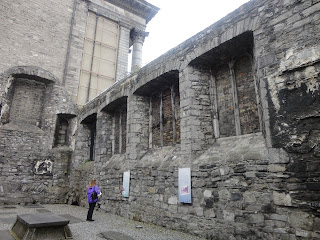I love churches.
There is just something so calming about going into a church. Not only that, but if the church is open to the public to view, then one can learn a lot about the community that the church serves.
In Medieval times, the church was the center of society. It was the glue that held society together in uncertain times. When I went to St. Audoen's Church, I learned how important the church was to the community.
The church is located right in the heart of the Medieval part of Dublin. St. Audoen's is the last remaining Medieval parish in Dublin. The church is named after St. Ouen (Audoen) of Normandy, who was a saint that lived in the 7th century. The land that the church is built on was dedicated by Anglo-Normans that arrived in Dublin after 1172. The church was built around 1190.
It was located in the commercial and industrial heart of Medieval Dublin. It was an important part in Medieval Dublin. If people needed help, they turned to the church. But starting in 1773, the congress of the church began to dwindle. Today, the church is still in use, but to a small group.
I loved learning about the importance of the church in Medieval times. St. Audoen's Church was great to explore, but it is by no means a must see. If one is at a lost as to what to do in Dublin, I would recommend it. It is free, so if you don't like it, you are not losing anything.
 St. Audoen's
St. Audoen'sTreasure of the church.
 Coat of arms for different guilds. The church was the center for these guilds of the community. They did important jobs like blacksmith work to even bakers.
Coat of arms for different guilds. The church was the center for these guilds of the community. They did important jobs like blacksmith work to even bakers. Old, Medieval sidewalk.
 Lucky Stone. This is from the 9th century and is carved with a Celtic cross. It stood outside the church for centuries and it was believed to bring good luck to all those who touched it.
Lucky Stone. This is from the 9th century and is carved with a Celtic cross. It stood outside the church for centuries and it was believed to bring good luck to all those who touched it. 


















































No comments:
Post a Comment